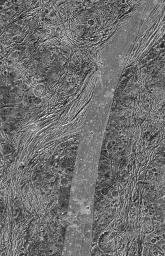
|
Regional View of Bright and Dark Terrain
- Click the image above for a larger view
- Full-Res JPEG (1249 x 1939) (598.8 kB)
- Full-Res TIFF (1249 x 1939) (2.9 MB)
Caption:
This view of the Nicholson Regio/Arbela Sulcus region on Jupiter's moon Ganymede, taken by NASA's Galileo spacecraft, shows the stark contrast between the smooth bright terrain and the surrounding highly fractured dark terrain.
This observation was designed in part to distinguish between different models for how Arbela Sulcus and other groove lanes on Ganymede were formed. The volcanic model suggests that a relatively clean, water-rich lava filled a tectonic depression, then cooled to create a smooth surface. Tectonic models suggest that focused faulting and deformation of older dark terrain destroyed the pre-existing texture, which was brightened by exposure of underlying, clean ice. Analysis of these photos suggests a third and unexpected possibility: Arbela Sulcus may be similar to some bands on another of Jupiter's moons, Europa, formed by tectonic crustal spreading and renewal.
North is to the upper left of the picture and the Sun illuminates the surface from the west. The image, centered at ?14 degrees latitude and 347 degrees longitude, covers an area approximately 258 by 116 kilometers (160 by 72 miles). The resolution is 133 meters (436 feet) per picture element. The images were taken on May 20, 2000, at a range of 13,100 kilometers (8,140 miles).
Background Info:
This image and other images and data received from Galileo are posted on the Galileo mission home page at http://www.jpl.nasa.gov/galileo . Background information and educational context for the images can be found at http://www.jpl.nasa.gov/galileo/sepo
The Jet Propulsion Laboratory, a division of the California Institute of Technology in Pasadena, manages the Galileo mission for NASA's Office of Space Science, Washington, D.C.
This image was produced by DLR (German Aerospace Center), Berlin, and Brown University, Providence, R.I., http://solarsystem.dlr.de/ and http://www.planetary.brown.edu/ .
Cataloging Keywords:
| Name | Value | Additional Values |
|---|---|---|
| Target | Ganymede | Europa |
| System | Jupiter | |
| Target Type | Satellite | |
| Mission | Galileo | |
| Instrument Host | Galileo Orbiter | |
| Host Type | Orbiter | |
| Instrument | Solid-State Imaging (SSI) | |
| Detector | ||
| Extra Keywords | Grayscale, Volcano, Water | |
| Acquisition Date | ||
| Release Date | 2000-12-16 | |
| Date in Caption | 2000-05-20 | |
| Image Credit | NASA/JPL/Brown University | |
| Source | photojournal.jpl.nasa.gov/catalog/PIA02573 | |
| Identifier | PIA02573 | |
